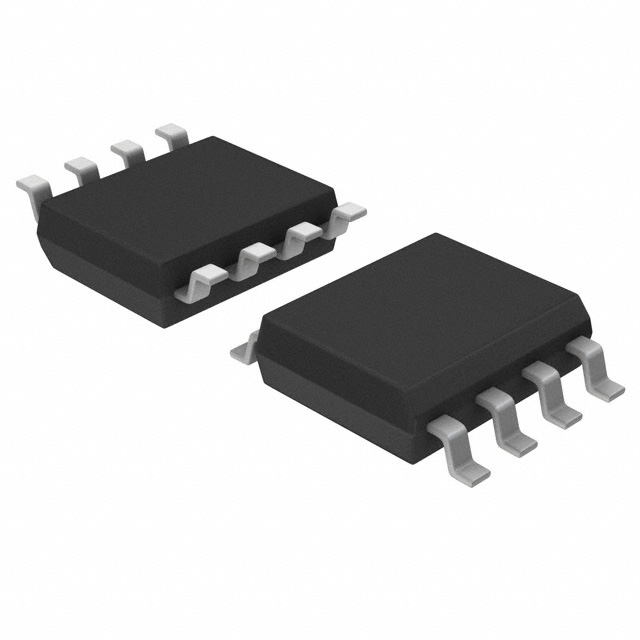Siehe Spezifikationen für Produktdetails.

DS90LV001TMX/NOPB
Product Overview
Category
The DS90LV001TMX/NOPB belongs to the category of high-speed differential line drivers and receivers.
Use
It is primarily used for transmitting and receiving high-speed digital signals over long distances.
Characteristics
- High-speed operation: The DS90LV001TMX/NOPB supports data rates up to 400 Mbps, making it suitable for applications requiring fast signal transmission.
- Low power consumption: It operates at a low supply voltage and consumes minimal power, making it energy-efficient.
- Differential signaling: It utilizes differential signaling to provide noise immunity and reduce electromagnetic interference (EMI).
- Wide temperature range: The DS90LV001TMX/NOPB can operate reliably in a wide temperature range, making it suitable for various environments.
- Robust design: It features built-in protection against electrostatic discharge (ESD) and other electrical transients, ensuring reliable performance.
Package
The DS90LV001TMX/NOPB is available in a small form factor package, such as a thin-shrink small outline package (TSSOP).
Essence
The essence of the DS90LV001TMX/NOPB lies in its ability to transmit and receive high-speed digital signals with low power consumption and robustness.
Packaging/Quantity
The DS90LV001TMX/NOPB is typically packaged in reels or tubes, with a quantity of multiple units per package.
Specifications
- Supply Voltage Range: 3.0V to 3.6V
- Data Rate: Up to 400 Mbps
- Operating Temperature Range: -40°C to +85°C
- Input Common Mode Voltage Range: -2V to +2V
- Output Voltage Swing: 350mV (minimum)
- Power Consumption: <10mW (typical)
Detailed Pin Configuration
The DS90LV001TMX/NOPB has a total of 8 pins, which are as follows:
- VCC: Power supply voltage input
- GND: Ground reference
- RXP: Positive differential receiver input
- RXN: Negative differential receiver input
- TXP: Positive differential transmitter output
- TXN: Negative differential transmitter output
- EN: Enable pin for controlling the driver/receiver operation
- NC: No connection (reserved pin)
Functional Features
- Differential Line Driver: The DS90LV001TMX/NOPB can drive high-speed differential signals on transmission lines.
- Differential Line Receiver: It can receive and convert high-speed differential signals back into digital data.
- Enable Control: The EN pin allows for easy control of the driver/receiver operation, enabling power-saving modes when not in use.
Advantages and Disadvantages
Advantages
- High-speed operation enables fast signal transmission.
- Low power consumption makes it energy-efficient.
- Robust design with built-in protection against ESD and electrical transients ensures reliable performance.
- Wide temperature range allows for versatile application in various environments.
- Differential signaling provides noise immunity and reduces EMI.
Disadvantages
- Limited to specific applications requiring high-speed signal transmission.
- May require additional components for complete system integration.
Working Principles
The DS90LV001TMX/NOPB operates based on the principles of differential signaling. It uses two complementary signals, one positive and one negative, to represent digital data. This differential signaling technique provides noise immunity and reduces the impact of common-mode noise and interference.
When transmitting, the DS90LV001TMX/NOPB converts digital data into differential signals and drives them onto the transmission line. On the receiving end, it receives the differential signals and converts them back into digital data.
Detailed Application Field Plans
The DS90LV001TMX/NOPB finds applications in various fields, including:
- High-speed data communication systems
- Industrial automation and control systems
- Automotive electronics
- Medical equipment
- Test and measurement instruments
- Telecommunications equipment
Detailed and Complete Alternative Models
- DS90LV001ATM/NOPB
- DS90LV001ATMX/NOPB
- DS90LV001TM/NOPB
- DS90LV001TMX/NOPB
- DS90LV011ATMF/NOPB
- DS90LV011ATMFX/NOPB
- DS90LV011ATMX/NOPB
- DS90LV011ATMX/NOPB
These alternative models offer similar functionality and characteristics to the DS90LV001TMX/NOPB, providing options for different design requirements.
In conclusion, the DS90LV001TMX/NOPB is a high-speed differential line driver and receiver that offers reliable performance, low power consumption, and robustness. Its wide range of applications and availability of alternative models
Listen Sie 10 häufige Fragen und Antworten im Zusammenhang mit der Anwendung von DS90LV001TMX/NOPB in technischen Lösungen auf
What is the operating voltage range of DS90LV001TMX/NOPB?
- The operating voltage range of DS90LV001TMX/NOPB is 3V to 3.6V.What is the maximum data rate supported by DS90LV001TMX/NOPB?
- DS90LV001TMX/NOPB supports a maximum data rate of 400 Mbps.Can DS90LV001TMX/NOPB be used in industrial applications?
- Yes, DS90LV001TMX/NOPB is suitable for use in industrial applications.What is the typical common-mode voltage range of DS90LV001TMX/NOPB?
- The typical common-mode voltage range of DS90LV001TMX/NOPB is -1V to 2.4V.Is DS90LV001TMX/NOPB compatible with LVDS standards?
- Yes, DS90LV001TMX/NOPB is fully compatible with LVDS standards.Does DS90LV001TMX/NOPB require external termination resistors?
- Yes, DS90LV001TMX/NOPB requires external termination resistors for proper operation.Can DS90LV001TMX/NOPB be used in automotive applications?
- Yes, DS90LV001TMX/NOPB is suitable for use in automotive applications.What is the power consumption of DS90LV001TMX/NOPB?
- The power consumption of DS90LV001TMX/NOPB is typically 100mW.Is DS90LV001TMX/NOPB RoHS compliant?
- Yes, DS90LV001TMX/NOPB is RoHS compliant.What is the package type of DS90LV001TMX/NOPB?
- DS90LV001TMX/NOPB is available in a small-outline package (SOIC) for easy integration into designs.

